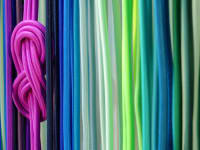This DIY décor trend can be toxic—here's how to stay safe
This buzzy spray foam project isn't worth the health risk.
Products are chosen independently by our editors. Purchases made through our links may earn us a commission.
Instagram is one of the best places to get design inspiration; it’s where trends on style, food, travel, and home décor are able to reach the masses, especially with most people still homebound.
Lately you can find post after post supporting a foam mirror trend—its funky, eclectic, and borderline bizarre look has graced Scandinavian influencers' and DIY enthusiasts’ pages. It can best be described as part of a dreamy aesthetic—think pastel pillows and rugs, as well as funky vases and candleholders.
But, unfortunately, it can be toxic if not applied or displayed correctly. Here’s what you should know about spray foam insulation and the potential dangers involved.
First, what is the foam mirror trend?
The foam mirror trend, in particular, is likely inspired by European artists, including Denmark-based Anna Thoma, who has been selling made-to-order foam mirrors since last summer, and Swedish designer Gustaf Westman, who has also created textured mirrors, along with matching coffee tables and end tables deemed “popcorn” style.
Now, DIY-ers and bloggers alike are creating their own projects at home using variations of spray insulation foam. Many are also spray painting the foam creations with pastel pink and orange hues for an even dreamier look.
To DIY or not to DIY
We wanted to try the foam mirror trend, too, since we’re always in the market for a good DIY project. But, after digging for more information on spray foam insulation products, we found the safety data sheet for Great Stuff Gaps & Cracks Insulating Foam Sealant, detailing the hazards and ingredients in the insulation.
So, instead, we set out to determine whether or not we should be trying the foam mirror trend at all. We spoke with Cristina Miguelez, a remodeling specialist at Fixr, and she gave us the down-low on spray insulation’s multitude of toxins and hazardous materials.
What is spray foam insulation?
Spray foam insulation—also known as expanded polystyrene (EPS for short)—is primarily used as an alternative insulation product to seal buildings and homes. It helps to retain warm or cool air and cut energy costs in the long run.
Professionals typically spray foam insulation during the construction of a home into uncovered walls, attics, and any other interior cavities. EPS can also be used to fill foundation cracks or exterior holes.
When used properly in the right space, spray foam insulation is generally safe.
Miguelez says, “When EPS is used in homes, it’s usually outdoors, on the exterior of the building, beneath the siding. It won’t cause problems this way.”
Misusing spray foam insulation can pose dangerous exposure
While any insulation is okay to use for its intended purpose, using it for a DIY project such as this one is not necessarily recommended. Miguelez tells us that spray foam insulation is “known to give off very high levels of VOCs [volatile organic compounds].”
VOCs contain an array of chemicals, which may have “short- and long-term adverse health effects,” according to the Environmental Protection Agency.
Miguelez says, “These VOCs have been linked to asthma, eye and skin irritation, and other respiratory illnesses. Even rigid foam panels made from [spray foam insulation] can give off VOCs.”
When applying spray foam insulation for a DIY project, the right personal protective equipment needs to be used. This includes wearing protective clothing, gloves, safety glasses, and a respirator, when a well-ventilated area isn’t available.
Why insulation as décor isn’t such a good idea
Several DIY spray foam project guides indicate that about 24 hours after the application, the spray foam should be dry and ready to be handled. But Miguelez disagrees.
“The VOCs don’t go away when the smell does,” she says. “They off-gas for five years. Fifty percent in the first year and the remaining 50% over the next four. Even if it doesn’t bother you the minute you do it, having it in an enclosed space, like a bathroom that isn’t properly ventilated, could lead to health problems down the road.”
Final verdict: You probably shouldn’t try this DIY trend
We asked Miguelez if she’d suggest trying the spray foam mirror trend, and she says she doesn’t recommend it. “It’s bad for you, and it’s bad for the environment. Branch out on your own and find a unique craft or material. Don’t follow this one.”
Instead, try these alternative trends

Plenty of other DIY home décor projects don't pose health risks. Instead of spray foam, create a sunburst or wrapped rope mirror.
Just because spray foam insulation projects are off the table, it doesn’t mean you can’t add a DIY decorative touch to a boring mirror.
We’ve found a few mirror alternatives for your next DIY project, including brightening up your home with a sunburst mirror. These gorgeous accents can add an extra dose of personality to the room. It’s easy to achieve a look similar to this accent mirror sold at Wayfair.
The Joyful Derivatives blog used wooden dowels to create the bursts and a Styrofoam disc to secure the dowels.
To create a nautical-inspired round rope mirror like this one at Pottery Barn, grab a circular mirror with a large border and some twisted rope with a color and texture you like.
Darling Daly Design wound the rope before securing it together with hot glue.
And, if you’re still longing for some texture on a plain mirror frame, consider doing as Running with Sisters has done by adding some fake flowers or vines for something that feels just as dreamy.
Simply adhere the fake flowers on to the mirror in your preferred arrangement using super glue or a hot glue gun. Similarly, you can wrap faux plants—like this artificial eucalyptus—along the mirror to add a little bit of greenery to the space.


